The Damped Lya Systems
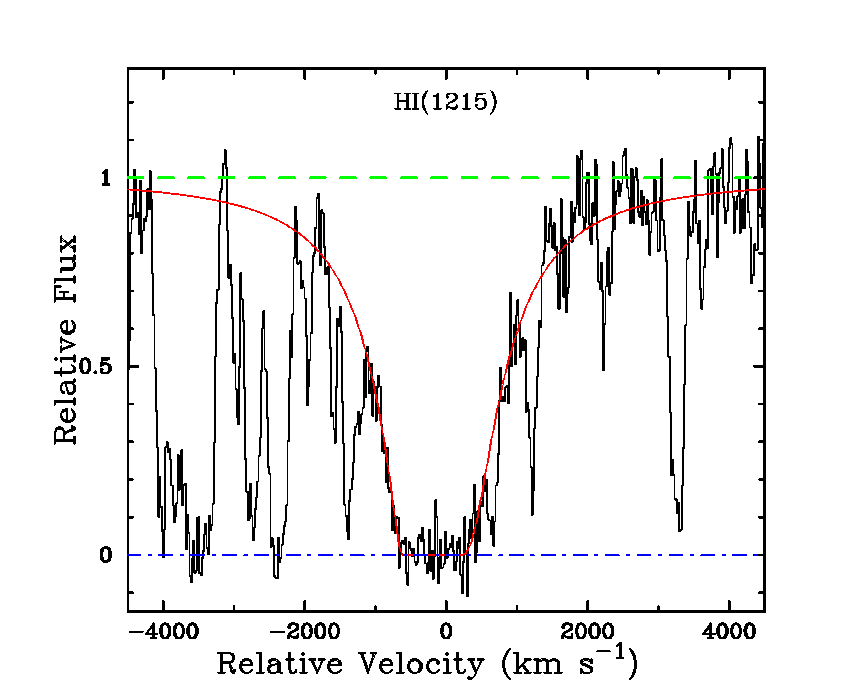 The story begins at UC San Diego in 1994 when
I signed on as a reearch student for
Dr. A.M. Wolfe.
While my first project was to investigate variations in
the fine-structure constant, I quickly moved onto damped systems.
In case the term 'damped Lya system' is a foreign
object to you, I should digress. The damped systems are a class
of quasar absorption line (QAL) system, specifically those QAL's with
HI column density,
N(HI) > 2 ×1020 cm-2.
On the right here is a fine example. The red line describes the fit to
the damped system; note in particular the damping wings of the profile.
It is these wings which allow a reasonably accurate N(HI) determination
even with moderate resolution and moderate S/N data. so, now, back to the
story...
The story begins at UC San Diego in 1994 when
I signed on as a reearch student for
Dr. A.M. Wolfe.
While my first project was to investigate variations in
the fine-structure constant, I quickly moved onto damped systems.
In case the term 'damped Lya system' is a foreign
object to you, I should digress. The damped systems are a class
of quasar absorption line (QAL) system, specifically those QAL's with
HI column density,
N(HI) > 2 ×1020 cm-2.
On the right here is a fine example. The red line describes the fit to
the damped system; note in particular the damping wings of the profile.
It is these wings which allow a reasonably accurate N(HI) determination
even with moderate resolution and moderate S/N data. so, now, back to the
story...
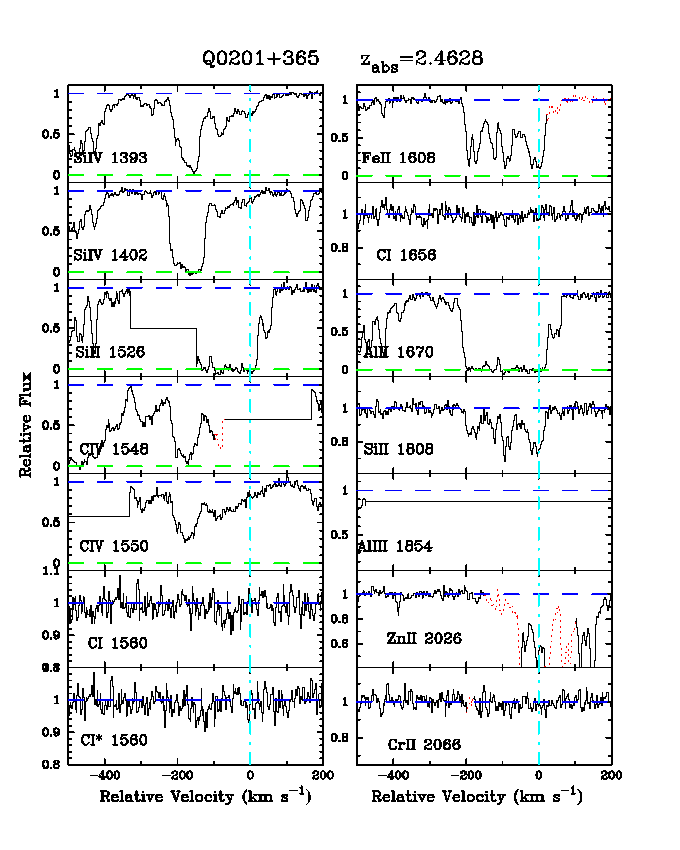
In what now seems like a remarkably logical sequence of events I started my damped Lya research by analysing in excruciating detail three damped Lya systems towards two quasars: Q0201+36 and Q2206-19. (The left figure here are the metal-line profiles from Q0201+36.) While pursuing these three damped systems, I refined various data reduction and analysis techniques and became quite intimate them. At the time I expected they were typical of all damped systems; in retrospect, they were anything but typical. They represent two of the most metal-rich systems and the most metal-poor damped system known. Similarly they have two of the largest and the smallest low-ion Dv (velocity widths). At least I learned a lot about what worked (and what failed) both in terms of kinematics and chemical abundances and was able to apply it to the high resolution damped survey that we carried out over the years to follow. Here are the two papers to appear on these systems:
Q0201+36.ps.gz; Prochaska & Wolfe 1996,
ApJ,470,403
Q2206-19.ps.gz; Prochaska & Wolfe 1997,
ApJ, 474,140
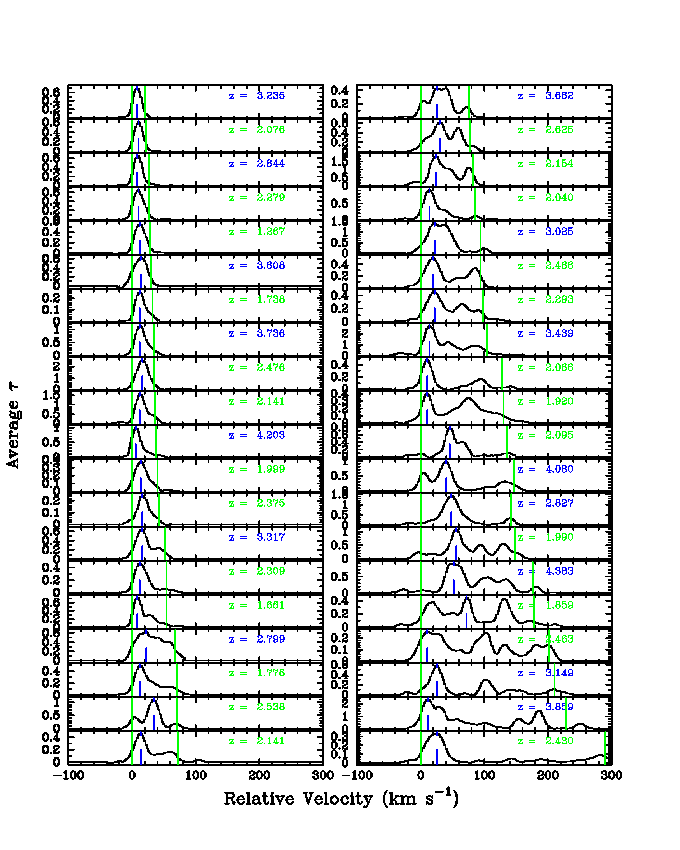 After finishing up these two sightlines, work began in earnest on modeling
the kinematics of the damped Lya systems. This was no small chore, as it
turned out. As with all projects it could probably take me a few weeks
to reproduce this year of effort, but so it went. Toyed around with
various kinematic tests and damped Lya models. It was clear from the start
that a thick disk model would almost trivially reproduce the kinematics,
IF the rotation speed was comparable to that of the Milky Way. Even to
this day, where the disk model is taking its hits, I still contend it
best stands up to Occam's Razor. In any case, after weeks of simulations on
each and everyone's computer in the group (I got desperate enough to include
several IPX's), the results were in. I don't think we fully appreciated the
'excitement' this would spark in the CDM community. Oh, but we did realize
soon enough.
After finishing up these two sightlines, work began in earnest on modeling
the kinematics of the damped Lya systems. This was no small chore, as it
turned out. As with all projects it could probably take me a few weeks
to reproduce this year of effort, but so it went. Toyed around with
various kinematic tests and damped Lya models. It was clear from the start
that a thick disk model would almost trivially reproduce the kinematics,
IF the rotation speed was comparable to that of the Milky Way. Even to
this day, where the disk model is taking its hits, I still contend it
best stands up to Occam's Razor. In any case, after weeks of simulations on
each and everyone's computer in the group (I got desperate enough to include
several IPX's), the results were in. I don't think we fully appreciated the
'excitement' this would spark in the CDM community. Oh, but we did realize
soon enough.
On the right here is a compilation of 40 damped Lya
low-ion profiles. Note the range in Dv
and the clear asymmetry in the majority of the wider profiles. Here are
the first papers on the subject:
On the Kinematics of Damped Lya Systems;
Prochaska & Wolfe 1997, ApJ, 486, 73
DLA at High z and Models of Protogalactic Disks;
Jedamzik & Prochaska 1998, MNRAS, 296, 430
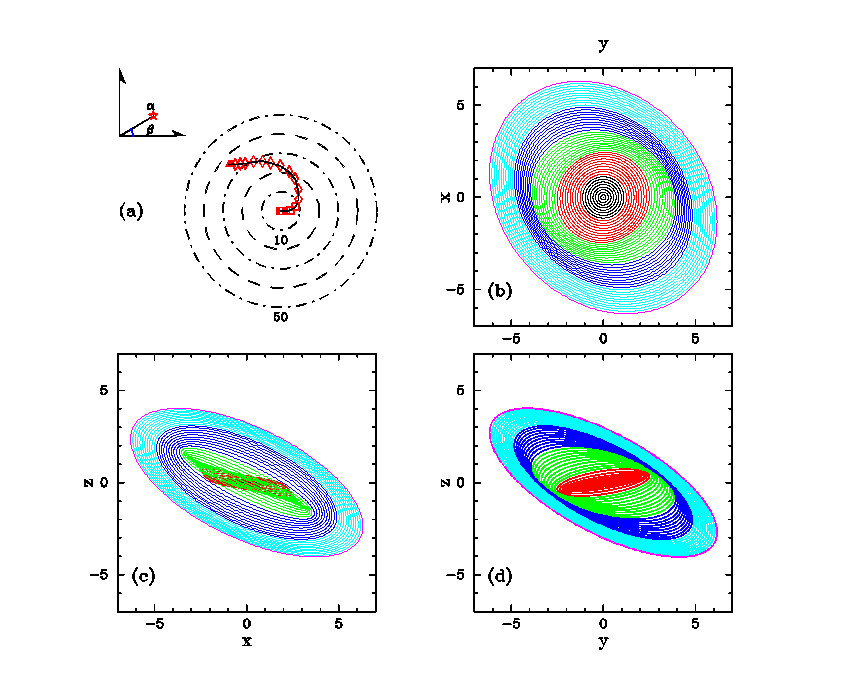 We felt that it was important to push the disk model reasonably hard to
see if it would break. This included adding in realistic rotation curves,
photoionization, and warping among other things. I'm sure we could have
tried a 100 other things, but these seem the most obvious and they
certainly were among the principal questions we fielded at talks and
conferences. Within reason, the model held up and still holds. I question
if competing models are anywhere as near as robust. On the right here is
a pretty picture which shows a warped disk. At least for HI, this is a
relatively common phenomenon. Here are the kinematic papers from around this
time:
We felt that it was important to push the disk model reasonably hard to
see if it would break. This included adding in realistic rotation curves,
photoionization, and warping among other things. I'm sure we could have
tried a 100 other things, but these seem the most obvious and they
certainly were among the principal questions we fielded at talks and
conferences. Within reason, the model held up and still holds. I question
if competing models are anywhere as near as robust. On the right here is
a pretty picture which shows a warped disk. At least for HI, this is a
relatively common phenomenon. Here are the kinematic papers from around this
time:
Protogalactic Disk Models of Damped Lya Kinematics; Prochaska & Wolfe 1998, ApJ, 507, 113 Investigating the Physical Nature of the DLA Systems at High Redshift; Prochaska 1999, Green Bank WV, High Redshift Radio Lines
The Physical Nature of the Damped Lya Systems; Prochaska 2000, IGRAP
Somewhere around this time, M. Haehnelt and the Steinmetz team showed that infalling protogalactic clumps could match the observed kinematics. The CDM community breathed a sigh of relief and life rolled along. I still think there are a zillion things to consider for all scenarios, although I admit we are probably learning more about galaxy formation than Cosmology. So perhaps it is best that the CDM crowd move elsewhere. Of course the whole crew hasn't shifted away. In particular, I have been working with Ari Maller and the head honcho's of Joel Primack's group at UC Santa Cruz to investigate the SAM models Rachel Sommerville and Joel devised. It's a work in progress, but we are learning some interesting things about the gas distribution required to match the SAM models with the DLA kinematics. Here is a preprint:
What Damped Ly-alpha Systems Tell Us About the Radial Distribution of Cold Gas at High Redshift; Maller, Prochaska, Somerville, & Primack 2000, MNRAS, submitted
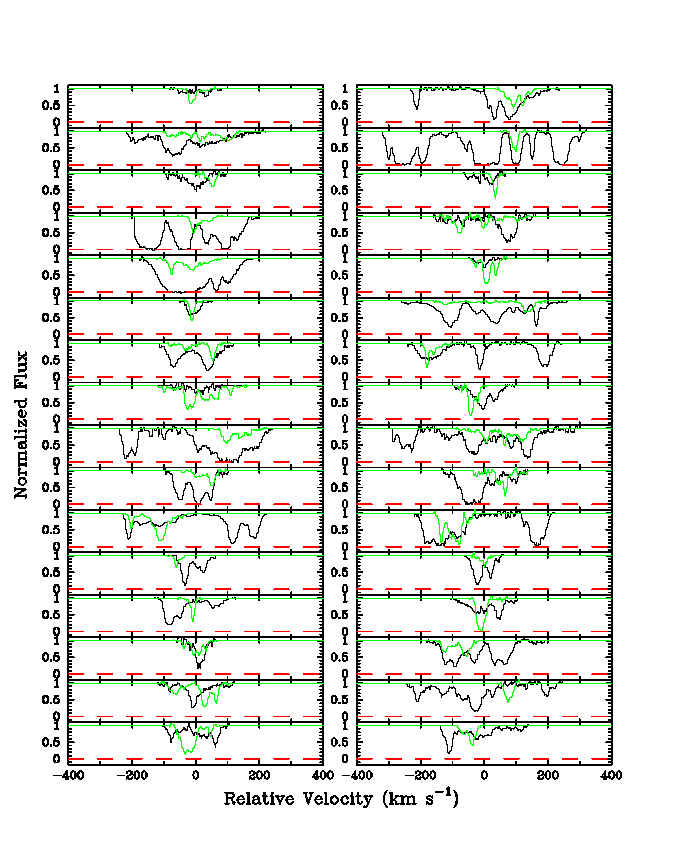 Most recently -- with respect to the DLA kinematics --
we (Art in particular) have been struggling with the high-ion
profiles, namely CIV, that arise in the damped systems. Their kinematics
offer a striking contrast to the low-ion profiles. What it all means is
still a bit of a mystery, but what does excite me is that the data is
forcing some rather clear requirements. This is particularly true when
you put the low-ion and high-ion profiles together.
Most recently -- with respect to the DLA kinematics --
we (Art in particular) have been struggling with the high-ion
profiles, namely CIV, that arise in the damped systems. Their kinematics
offer a striking contrast to the low-ion profiles. What it all means is
still a bit of a mystery, but what does excite me is that the data is
forcing some rather clear requirements. This is particularly true when
you put the low-ion and high-ion profiles together.
We finally have published this work. The first paper presents the observations
and a few new quantitative measures comparing the high-ion and low-ion
kinematics. The second paper introduces what we considered the first order
model of protogalaxies in the early universe. Namely, rotating disks within
halos filled with infalling hot gas. To our surprise, this model doesn't
work no matter what one assumes about the disks. Am very curious to find
out how the CDM cosmology handles all of this..
Ionized Gas in Damped Lyman Alpha Protogalaxies: I. Model-Independent Inferences From Kinematic Data; Wolfe & Prochaska 2000a, ApJ, in press
Ionized Gas in Damped Lyman Alpha Protogalaxies: II. Comparisons Between Models and the Kinematic Data; Wolfe & Prochaska 2000b, ApJ, in press
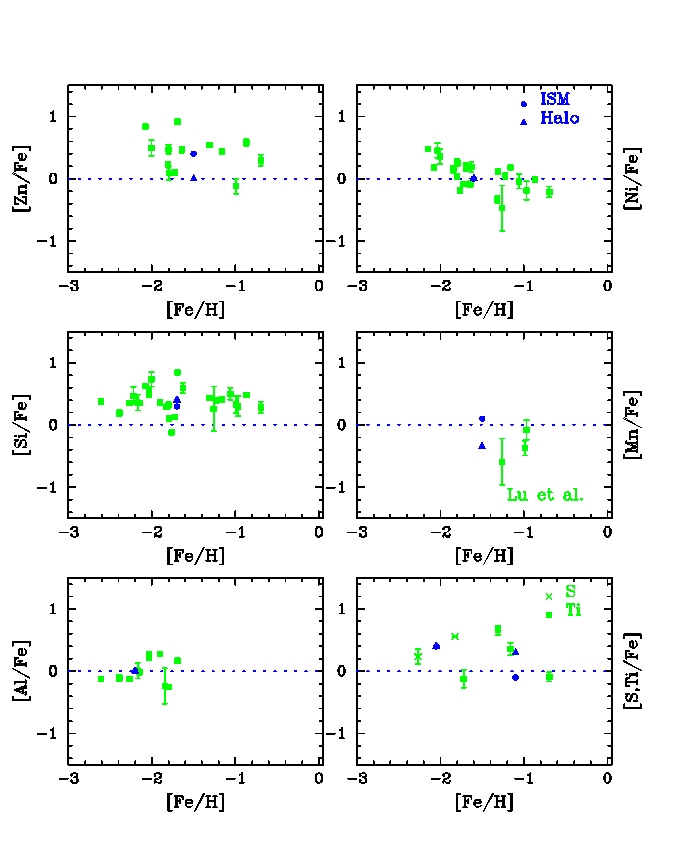 But what about chemical abundances, you cry!
As part of my thesis, I decided to gather all of our damped systems together
and compare abundance patterns. Up until this point, I considered this
Limin Lu's territory and had little interest in pursuing chemical abundances.
I had dabbled a little bit with Q0201+36 and Q2206-19, but nothing too
serious. In any case, I
derived results pretty much in line with
Lu et al. (1996) and as Limin
moved onto bigger and brighter things, I decided to
become a player in this 'mess'.
And a mess it is. The more I think about what the abundance patterns tell
us, the less I understand.
The Zn/Fe overabundance is pretty tough to
argue with, but Mn/Fe sure tells a different story. I think I might have
to agree with Dr. Burles who first made me think seriously about a combination
of Type II and dust.
What makes this game even more fun is that people
seem to have very set preconceptions and rarely like to budge on them.
Am hoping that the next generation of echelles (UVES and MIKE) really put
the whole business in a new light. There is the strong potential for OI
measurements, many more TiII and MnII observations and Zn at
But what about chemical abundances, you cry!
As part of my thesis, I decided to gather all of our damped systems together
and compare abundance patterns. Up until this point, I considered this
Limin Lu's territory and had little interest in pursuing chemical abundances.
I had dabbled a little bit with Q0201+36 and Q2206-19, but nothing too
serious. In any case, I
derived results pretty much in line with
Lu et al. (1996) and as Limin
moved onto bigger and brighter things, I decided to
become a player in this 'mess'.
And a mess it is. The more I think about what the abundance patterns tell
us, the less I understand.
The Zn/Fe overabundance is pretty tough to
argue with, but Mn/Fe sure tells a different story. I think I might have
to agree with Dr. Burles who first made me think seriously about a combination
of Type II and dust.
What makes this game even more fun is that people
seem to have very set preconceptions and rarely like to budge on them.
Am hoping that the next generation of echelles (UVES and MIKE) really put
the whole business in a new light. There is the strong potential for OI
measurements, many more TiII and MnII observations and Zn at
Chemical Abundances in the z>1.7 Damped Lya Systems;
Prochaska & Wolfe 1999, ApJS, 121, 369
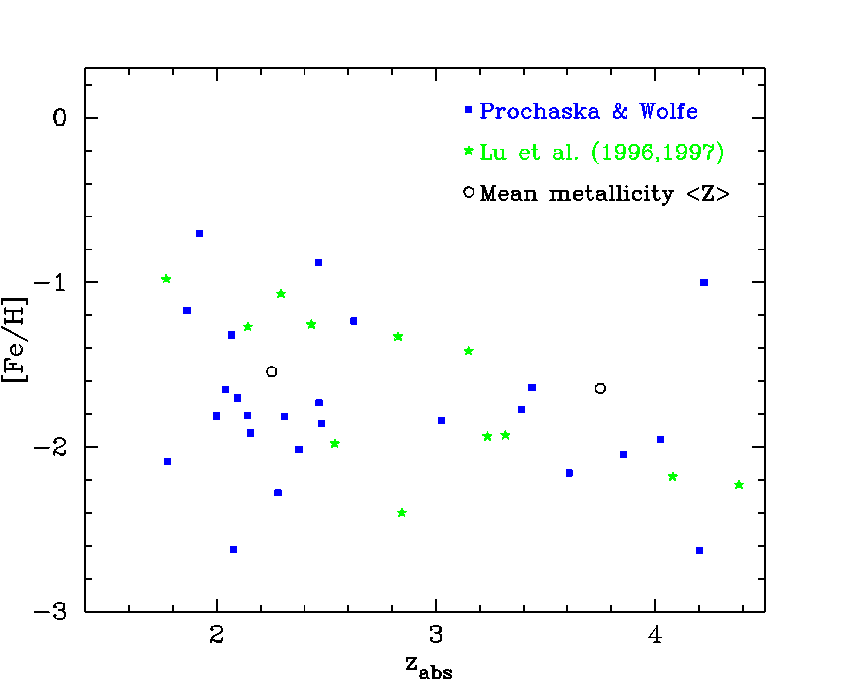 Finally, I decided to throw all of our damped systems and all of those from
Limin and Sargent to see how [Fe/H] evolved in time. While I had hinted
in Prochaska & Wolfe (1999)
that there may not be a significant evolution
in the N(HI)-weighted mean metallicity, there weren't near enough systems
in our sample for me to begin believing it. After putting together all of
the [Fe/H] measurements, this throw-away comment became considerably more
robust. Undoubtedly, it could still all be small number stats, but it'd
sure give the chemical evolution theorists a few things to think about if
there was almost no metallicity evolution from z = 2-4.5. Add in Max's results for Zn, and you might have minimal evoltuion
from z ~ 1-4.5! A few years with
ESI should be enough to put this picture on firm footing, whatever the
answer may be. Here are the results as they stand today:
Finally, I decided to throw all of our damped systems and all of those from
Limin and Sargent to see how [Fe/H] evolved in time. While I had hinted
in Prochaska & Wolfe (1999)
that there may not be a significant evolution
in the N(HI)-weighted mean metallicity, there weren't near enough systems
in our sample for me to begin believing it. After putting together all of
the [Fe/H] measurements, this throw-away comment became considerably more
robust. Undoubtedly, it could still all be small number stats, but it'd
sure give the chemical evolution theorists a few things to think about if
there was almost no metallicity evolution from z = 2-4.5. Add in Max's results for Zn, and you might have minimal evoltuion
from z ~ 1-4.5! A few years with
ESI should be enough to put this picture on firm footing, whatever the
answer may be. Here are the results as they stand today:
Metallicity Evolution in the Early Universe;
Prochaska & Wolfe 2000, ApJ, 533, L5
Last, but not least, Wolfe et al. (myself included) have an ongoing project to search for the stellar systems - a.k.a. galaxies - associated with the damped Lya systems. Ideally, we will study the actual galaxies causing the absorption (a la Djorgovski), but at the least we will be able to measure the bias of the galaxies associated with damped systems. It is a challenging program, all the more so because we are all new to photometry and multi-slit observations. Of course, this makes the science all the more fun. Hopefully, by the end of the year we will have enough results to offer some convincing results..
Carnegie Observatories
813 Santa Barbara St.
Pasadena, CA 91101
Phone: 626/304-0239; Fax: 626/795-8136;
e-mail: xavier@ociw.edu
modified 10/23/00